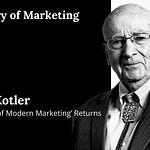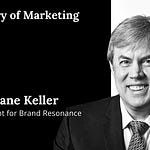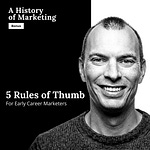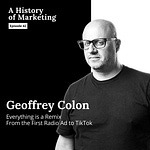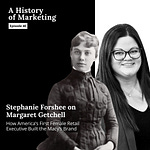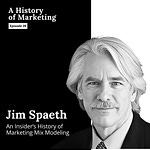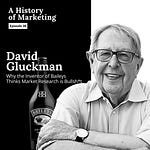A History of Marketing / Bonus Episode
This week’s conversation with Paul Feldwick was so packed with histories and insights that I simply couldn't fit everything into one episode. So, I cut out one of my favorite parts to share with you as a separate “Bonus Episode.” (Even if you’ve heard the main episode, this will be new to you.)
Paul shares the behind-the-scenes story of the iconic 1990s Barclaycard ads, starring the comedian Rowan Atkinson. Atkinson used these ads to develop the spy character that would become Johnny English.
Listen to the podcast: Spotify / Apple Podcasts / YouTube Podcasts
Feldwick worked on these ads when he was Executive Planning Director at BMP DDB Needham Worldwide, the lengthy-named agency behind Barclaycard’s classic campaign. The execution took so many unlikely twists and turns, Paul wrote the story as a case study for WARC (World Advertising Research Center) and in his book "Why Does The Pedlar Sing?"
To give you a sense of how legendary this story is, the late Jeremy Bullmore once wrote:
“It's possible that the only honest case-study in the history of marketing is the Barclaycard case written by Paul Feldwick... it describes in hilarious detail just how luck, agency obduracy and a collision of events entirely fortuitously led to an award-winning campaign of great commercial effectiveness.”
I love this case study because it articulates so much about the messy relationship between clients and agencies, strategy and creativity, and how seemingly obvious insights like, “Rowan Atkinson is funny” can lead to successful marketing campaigns.
I hope you enjoy it. And be sure to listen to my full interview with Paul Feldwick if you haven’t already. Paul is entertaining and persuasive throughout.
More from Paul Feldwick:
Paul just published Creative Awards: A Very Short History, which argues that ad industry awards judge “aesthetics” at the expense of “effectiveness” and attempts at assessing loftier values like “purpose” are misguided.
Paul’s excellent TEDx Talk Aesthetics And Jugs And Rock'n'Roll, discussed towards the end of the main episode.
Note: A special thank you to Xiaoying Feng, a Marketing Ph.D. Candidate at Syracuse, who volunteers to review and edit transcripts for accuracy and clarity.
The Disconnect Between Strategy and Execution
Paul Feldwick: There's a lengthy story at the start of Why Does the Pedlar Sing? about a campaign for a credit card called Barclaycard, which is still a very big brand in the UK, a campaign using Rowan Atkinson, which we did in the early 1990s.
Andrew Mitrak: These ads, I was not familiar with them, I'm from the US, but they're so good and they're so funny. And I watched them on YouTube. I encourage listeners to go to YouTube, if you just search "Barclaycard ads," it'll probably autofill and find these Rowan Atkinson ones. And they're so funny, so clever, and they usually are about a minute long or so, they're almost little short films.
Paul Feldwick: They're 60-second ads. I mean, the great thing nowadays is that so many ads are instantly available on YouTube, or other platforms, but mainly YouTube is usually the best place to start. And you have to remember that even 30 years ago, that simply wasn't the case. I mean, 30 years ago, if you wanted to say to somebody, "you should see this great ad for Barclaycard with Rowan Atkinson," it would involve getting hold of a copy of a video cassette that had this ad on it, you know, in a format that you could access. So we take that so much for granted now, but it does make it much easier to have these conversations.
But I brought it up, as I say, I write extensively about it in the first couple of chapters of Why Does the Pedlar Sing? because it's such a great example of the disconnect between what we actually ended up doing, which was producing something that was first and foremost, whatever else it did, it was entertaining. It works because it's entertaining, it works because it's funny, it works because it's got high production values, it works because it's a very enjoyable piece of 60-second cinema that people watch. And yet, at the time we were doing it, although part of us knew that was what we were doing, we also still were having to pretend that this was all about just communicating a product benefit in a sort of slightly clever way. So there was this doublethink always going on. And I suspect where it works, it does still go on. Although perhaps partly as a result of what I've written, and maybe some other things that are going on, I do sense that in the last 5 or 10 years, it's become more acceptable to talk about advertising as entertainment. There was a time when that was something you almost couldn't say, because it would immediately invite a lot of people going, "advertising is not meant to be entertaining, it's meant to be selling," you know. You can still find plenty of people who will bang that particular drum.
“The Only Honest Case Study in the History of Marketing"
Andrew Mitrak: Let's come back to this Barclaycard example because there's a quote that I pulled that's from Jeremy Bullmore. The quote is, "It's possible the only honest case study in the history of marketing is the Barclaycard case written by Paul Feldwick."
Paul Feldwick: I actually did write the account of how we got to this campaign, quite a long time before I wrote Why Does the Pedlar Sing? I wrote it as a sort of standalone article, probably about 20 years ago now, I would think. And I just felt the story needed to be told before it all got completely forgotten. And I just told it to the best of my ability. Because what happened, and I think anyone who's worked in an advertising agency will recognize that this is not that unusual, although this may be a fairly extreme example. But what happened was we were pitching for the Barclaycard account, and we won the pitch with a particular campaign, which was nothing like the campaign that eventually ran. And this is very typical, actually. As I'm sure you know, a lot of pitch-winning campaigns for one reason or another, they never win. It was a totally, totally different kind of campaign. It was based on a sort of a very abstract idea, if you like, which was, Barclaycard, we think it's all the credit cards you'll ever need. And this was illustrated with some very dramatic, very expensive film, which was going to involve people like running up the stairs of skyscrapers and standing on the roof of skyscrapers and cutting up all their other credit cards and throwing them to the four winds so that they'd flutter down into the streets. I mean, you can sort of picture how this could have been done in a very dramatic way with music building to a great climax. This was about the time that, you know, Saatchi's had just done those sort of big ads for British Airways which were done on an epic scale. It was, you know, it was sort of about 1990, it was that that sort of mood.
Note - For more on this era of advertising and Saatchi’s British Airways adverts, see my conversation with Mark Tungate
When the Pitch-winning Idea Won’t Actually Work
Paul Feldwick: This was what won the, won the campaign. And so everyone was sort of very enthusiastic about it, of course. I mean, the client had bought it, we'd won the campaign with it, everybody loved it. And then things started going wrong. We started doing some research, and the researchers came back and said, "Actually, the public don't seem to really like this campaign very much. They don't really get it, they're not very excited by it." But because everyone was so invested in it, they didn't dare say, "We think you should can it and start again." They said, "I'm sure we can just make it work with a little bit of tweaking." So they were doing that. And then meanwhile, we were also finding the campaign was going to be incredibly expensive. And we were also finding that, you know, every ad that ran on British television then as now had to go through some sort of copy clearance committee. So there were various hoops that they'd have to pass and they were saying things like, "Well, look, you can't show other people's credit cards or be seen to be cutting them up. And you certainly can't be seen to be throwing them off buildings because that'll be like littering," and stuff. So there were all sorts of problems with this campaign. But nevertheless, nobody, there was a kind of groupthink thing going on. Nobody could get their head at all around saying, "Perhaps we should stop and do something different," because this was the great pitch-winning campaign, you know, and nobody could dare say a word against it.
So, to cut a long story short, the agony was prolonged for about six months, during which we tried to make this campaign work. And every time we tried to make it work, it got worse and worse and worse. So, you know, it ended up, it ended up with like literally one man standing on a fire escape cutting up a credit card and putting it in a brown paper bag. And people were kind of going, "What the hell is all that about?" So we were finally bumped into a sort of, and it was a really important relaunch for the client as well. This wasn't just a new campaign, there was a huge amount riding on this. They were relaunching the whole brand, they were introducing for the first time a fee for the cardholders. You know, and everything was built around a particular date when this relaunch was going to take place. So, you know, there was a deadline, there was a huge amount riding on it. And, you know, this is the point at which I'm sure they must have been tempted at some point to say, "Let's fire the agency and start again," except they didn't really have the time to do that either. So we were kind of stuck with each other.
The Birth of a Classic Campaign: “You should use Rowan Atkinson because he’s funny”
Paul Feldwick: I'll cut to the chase. With a bit of to-ing and fro-ing, at the very last minute, somebody came up with like the third or fourth idea, which was, "We'll use, we'll write some scripts around Rowan Atkinson." And we took those out to research and they weren't very good, even so, and people didn't get it. And I had to come back from this research, which I, at this point I was conducting the research myself. And I came back and I said, "The only thing I can salvage from this research is that people really like Rowan Atkinson and they say you should use Rowan Atkinson because he's funny whatever he does."
And at the same time, we were in touch with Rowan Atkinson, and he was quite keen to do advertising, but he was also, he had a whole character that he wanted to develop, which he'd come up with entirely, which was the character that eventually turned into Johnny English many years later on. So he said, "Well, I've got this idea for a character." So anyway, one thing led to another, and we got to a point where we all just had to kind of trust the process, trust Rowan Atkinson, trust each other to develop, and our creative department became involved in writing the scripts. And we shot the first few films, and there wasn't even time to research them before we went on air. We just had to kind of believe in it. We researched them as soon as they went on air, because worst-case scenario, there was a point there where we could do something about it if it was terribly bad. But fortunately, it wasn't terribly bad, it was actually brilliant.
Allowing for improv while sticking to product messaging
Paul Feldwick: And it took me a long time to make sense of that story. There's, as Jeremy says, you know, this is a very funny story in some ways, and it's the kind of story that people in advertising agencies actually like to tell to each other in the pub along the lines of, "Oh, you know, well, we farted around for six months and we got it all horribly wrong, and then just at the last minute, we got lucky and we were able to sort of save the day." And that's one way of telling the story, that's close enough to the truth to be plausible, but it doesn't really tell you quite enough. It doesn't really tell you anything useful to learn from, because, you know, if you're a client hearing that story, you think, "Well, that's all very well, but that's not really how I want my advertising development process to go." So I wanted to sort of think, "How else can we tell that story so that we can learn something from it?"
And what it seemed to me had happened was that throughout the sort of initial development process of the pitch and then working with the campaign after the pitch, we were still very wedded to a very traditional model of how we thought that advertising was meant to work, which was, you know, you have a proposition and you find a way of dramatizing the proposition, and that's what's going to somehow persuade people that Barclaycard is the better brand. And then because we were so up against it and we had to change our minds very much at the last minute, and because we then suddenly lighted upon this brilliant comedian, Rowan Atkinson, and his equally brilliant producer-director, John Lloyd, who was working with him, we were suddenly, we moved into a different realm altogether where suddenly in the realms of show business.
And the shoots were very interesting because they were all location shoots. And Atkinson and Lloyd and all those team were there, and the agency creative teams were there. And some of the clients were there as well, but they were kind of, they were out of the office. They were in places like Marrakesh and, you know, Moscow. And to some extent, they had a script, but they were also, they were shooting it as if it was a comedy show, so that it was like, if you said the line and it wasn't funny enough, Rowan Atkinson would say, "Well, look, let's rewrite the script." And they did. So there was a lot of room for improvisation in it as well. And the reason that those ads are so successful and so funny, and that they still stand the test of time in most cases 30 years on, is because that was the approach that went into making them. It was not the traditional advertising agency, client breathing down your shoulder, "We have agreed every word of this script and we have got to do it exactly the way that we agreed it with the client, and we have got to get in three mentions of the product," and so on and so on. It was much more done in a way of, above all, this has got to work as a piece of film.
And so it did. That was how they made it work. Which is not to say it's self-indulgent or it doesn't do the job. It does the job brilliantly. And I think we always felt that actually, because, you know, people like Rowan Atkinson and John Lloyd didn't have anything to prove, they didn't have any axes to grind. They didn't have any problem with thinking, realizing this is an advert, you know, we're here to sell the product. So that you'll notice when you look at some of these scripts how Rowan Atkinson gets the brand name into just about every line in a totally seamless way. He's always sort of, you know, he's the guy who refuses to use the Barclaycard, and he's arguing with his assistant who's the guy who does have the Barclaycard. He's thinking like, "Barclaycard, Boff. What do I need a Barclaycard for? I managed perfectly well without a Barclaycard." So it all happens quite seamlessly, but it's just done in a way that works. And I think looking back on it now, I think that we made this huge leap without quite realizing it from thinking like a sort of old-style ad agency and thinking, you know, plonk, plonk, plonk, to thinking like entertainers. And that's why those ads are so, and I mean, it needs to be said, because we haven't said this so far, but what's crucial to this story is that campaign was incredibly successful. I mean, it wasn't just, "These are great ads that the ad industry thinks are wonderful." These were ads that were hugely popular, hugely famous, and as a result, did an incredibly strong job for Barclaycard. And they are still probably in the UK, just about the only ads for Barclaycard that most people will remember as long as they're old enough to remember them.
So that for me became the start point for Why Does the Pedlar Sing? because that was building on the idea that so much successful brand advertising has its roots in the whole world of entertainment and show business rather than in that sort of world of propositions and reasons why, which is another kind of advertising history, but increasingly, I think, not the most important or relevant one to what advertising in that kind of sense achieves.
Path dependency: The process and end result would not have won the pitch
Andrew Mitrak: What's funny is that despite all the success and even your case study of these ads, that it is show business. It's Rowan Atkinson is funny and whatever he's in, and you just got to trust him and let him improvise and all that. The agency could never sell that to the client. They want all the analysis, the positioning, the branding, the data, the research, the focus groups. They want all of that, and that's just the process through which they buy that, even though there's evidence to the contrary.
Paul Feldwick: That is a fundamental cultural issue. And, you know, it's still very, very rare that people kind of get that right. I've seen examples, you know, continually, one sees examples of campaigns. I mean, there was a campaign a few years ago in the UK for Tesco, a big supermarket.
And it should have been great because they hired some really brilliant, famous entertainers to do it. They hirednRuth Jones and James Corden, I think, and you know, the people who did Gavin & Stacey or whatever. And you see the ads and they're just kind of, they're leaden, they're sort of flat. And you can just sort of get this feeling that everything has been overcontrolled, so that it loses that magic that it needs to become a piece of entertainment. And it's that aesthetic quality which is so important in making the difference between an advertising campaign that sort of flies and one that doesn't. And it's quite an intangible quality. So, you know, it's a cultural thing that people think they're playing safe by trying to control everything. And in fact, they are not playing safe because they are jeopardizing the very thing that they're trying to achieve. And I think that's still happening, if it's still happening, because people are still not clear enough in their mind that they need to make this leap. And to some extent, the advertising industry has itself to blame for all this.



